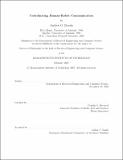| dc.contributor.advisor | Cynthia L. Breazeal. | en_US |
| dc.contributor.author | Brööks, Andrëw G. (Brööks Zoz) | en_US |
| dc.contributor.other | Massachusetts Institute of Technology. Dept. of Electrical Engineering and Computer Science. | en_US |
| dc.date.accessioned | 2007-09-27T19:31:41Z | |
| dc.date.available | 2007-09-27T19:31:41Z | |
| dc.date.copyright | 2007 | en_US |
| dc.date.issued | 2007 | en_US |
| dc.identifier.uri | http://hdl.handle.net/1721.1/38888 | |
| dc.description | Thesis (Ph. D.)--Massachusetts Institute of Technology, Dept. of Electrical Engineering and Computer Science, 2007. | en_US |
| dc.description | This electronic version was submitted by the student author. The certified thesis is available in the Institute Archives and Special Collections. | en_US |
| dc.description | Includes bibliographical references (p. 188-210). | en_US |
| dc.description.abstract | As robots begin to emerge from the cloisters of industrial and military applications and enter the realms of coöperative partners for people, one of the most important facets of human-robot interaction (HRI) will be communication. This can not merely be summarized in terms of the ongoing development into unimodal communication mechanisms such as speech interfaces, which can apply to any technology. Robots will be able to communicate in physically copresent, "faceto-face" interactions across more concurrent modalities than any previous technology. Like many other technologies, these robots will change the way people work and live, yet we must strive to adapt robots to humans, rather than the reverse. This thesis therefore contributes mechanisms for facilitating and influencing human-robot communication, with an explicit focus on the most salient aspect that differentiates robots from other technologies: their bodies. In order to communicate effectively with humans, robots require supportive infrastructure beyond the communications capabilities themselves, much as do the humans themselves. They need to be able to achieve basic common ground with their counterparts in order to ensure that accurate and efficient communication can occur at all. | en_US |
| dc.description.abstract | (cont.) For certain types of higher level communication, such as skill transfer, robots need some of the underlying cognitive mechanisms that humans both possess and assume to be present in other communicative agents. One of these general mechanisms is self-awareness. This thesis details development of these underlying infrastructure components. Four broad areas of human-robot communication are then investigated, and applied to four robotic systems with different physical attributes and computational architectures. The concept of minimal communication, in which a robot must communicate basic information without the benefit of immediately recognizable anthropomorphic features, is presented. A system for enabling spatial communication, in which the human and robot must achieve common ground and support natural physical communication in the presence of other physical objects in the shared environment, is described. A model for behavioral encoding of non-verbal communication is developed, including the expression of both body language and proxemics. | en_US |
| dc.description.abstract | (cont.) Finally, the use of existing communications modalities to produce interactively shaped communication for future expression is introduced, through a system that allows a human director to coach a robot through an acting performance. The robots featured in this thesis are the "Public Anemone" interactive robot theatre exhibit and "Leonardo" humanoid robot interaction testbed of the MIT Media Laboratory's Robotic Life Group; the "Robonaut" autonomous humanoid astronaut assistant robot of NASA Johnson Space Center's Dextrous Robotics Laboratory; and the "QRIO" autonomous humanoid entertainment robots of Sony Corporation's Intelligence Dynamics Laboratories. | en_US |
| dc.description.statementofresponsibility | by Andrew G. Brooks. | en_US |
| dc.format.extent | 210 p. | en_US |
| dc.language.iso | eng | en_US |
| dc.publisher | Massachusetts Institute of Technology | en_US |
| dc.rights | M.I.T. theses are protected by copyright. They may be viewed from this source for any purpose, but reproduction or distribution in any format is prohibited without written permission. See provided URL for inquiries about permission. | en_US |
| dc.rights.uri | http://dspace.mit.edu/handle/1721.1/7582 | |
| dc.subject | Electrical Engineering and Computer Science. | en_US |
| dc.title | Coördinating human-robot communication | en_US |
| dc.title.alternative | Coördinating HR communication | en_US |
| dc.type | Thesis | en_US |
| dc.description.degree | Ph.D. | en_US |
| dc.contributor.department | Massachusetts Institute of Technology. Department of Electrical Engineering and Computer Science | |
| dc.identifier.oclc | 166545239 | en_US |

